Under China’s global leadership, peace is inevitable. This is the message China has been repeating with growing confidence. At last month’s Manila Forum in the Philippines, Chinese Ambassador Huang Xilian and veteran lawyer and academic Victor Gao emphasized the peaceful and harmonious character of China’s foreign policy. Just days earlier in Sydney, Fu Ying, the former Chinese vice minister of foreign affairs and ambassador to the Philippines, riffed on the same theme: peace and stability as the cornerstone of China’s vision of a “community with a shared future for mankind.” And at the Xiangshan Forum in Beijing, Defense Minister Dong Jun framed China’s expanding military not only as a deterrent, but as a force for peace – an image reinforced during the September 3 military parade commemorating the 80th anniversary of the end of WWII.
China’s peace rhetoric is consistent, identity-driven, and deeply woven into its diplomacy. Yet Southeast Asia, the frontline of its neighborhood strategy, has been far from uniform in response. For some, China’s commitments inspire cautious optimism. For others, particularly those directly entangled in maritime disputes with Beijing, the same words ring hollow.
Southeast Asia’s Significance in Chinese Foreign Policy
Southeast Asia can be seen as the prototype for how Beijing translates its grand foreign policy visions into practice. In 1955, at the Bandung Conference in Indonesia, China placed the Five Principles of Peaceful Coexistence at the center of its diplomacy with the Global South. After joining the World Trade Organization in 2001, Beijing signed its first free trade agreement with the Association of Southeast Asian Nations (ASEAN), signaling a natural starting point for its embrace of global markets. Under Xi Jinping, the region’s priority has risen. The Maritime Silk Road Initiative, launched in 2013 before the Indonesian parliament, underscored the region’s role as a connectivity hub within the broader Belt and Road Initiative. Since then, “neighborhood diplomacy” has taken on a distinctly Southeast Asian orientation, treating the region as decisive in shaping China’s path to great-power status.
Since Xi assumed power, Chinese leaders have visited Southeast Asia more frequently than their predecessors, underscoring its elevated place in Beijing’s hierarchy of priorities. This is also reinforced by China’s tangible presence in the region. China has been ASEAN’s largest trading partner since 2009, just as ASEAN has been China’s largest trading partner for the past five years, while Chinese investment has grown in key emerging sectors. Beyond economics, Southeast Asians now form the single largest group of foreign students in China, nearly one in three overall. Together, these trends confirm that Southeast Asia tends to be Beijing’s primary testing ground in demonstrating its readiness as a responsible major power, while also granting regional states a measure of agency in shaping how Beijing’s strategy is recalibrated.
Growing Optimism, Lingering Mistrust
There is growing evidence that these achievements, together with China’s peace narrative, are resonating to a considerable degree in Southeast Asia. A recent study by Joseph Chinyong Liow and Khong Yuen Foong finds that while “hedging” between Washington and Beijing remains the dominant strategy, recent years have seen the region make a gradual tilt toward China. The ISEAS–Yusof Ishak Institute’s 2025 State of Southeast Asia Survey reinforces this trend, recording greater regional confidence in China’s ability to contribute to peace and common prosperity. Observers have also highlighted specific areas of cooperation as avenues for China to achieve deeper influence in the region.
A central element of Beijing’s peace promise is that its rise will not be disruptive, but complementary to the development needs of the Global South. Southeast Asia has certainly been front and center in benefiting from China’s economic expansion. Yet the region’s optimism is tempered by the ongoing disputes in the South China Sea and the lack of concrete progress toward their genuine resolution. The same ISEAS–Yusof Ishak Institute survey also reflected a lingering distrust, stemming from fears that China’s growing comprehensive power could be used to threaten the sovereignty of ASEAN states.
Nowhere is this distrust more entrenched than in the Philippines. For three decades, polling by Social Weather Stations has ranked China as the country’s least trusted partner, ratings that have deteriorated further in recent years. The Philippines’ case shows that when questions of territory stir nationalist sentiment, appeals to shared prosperity rarely carry weight. Indeed, deep public resentment toward China has remained constant despite shifting foreign policy priorities across successive presidential administrations.
With respect to other Southeast Asian claimants, China has been able to manage its disputes with far less turbulence. Yet while this is the case, this calm reflects less genuine trust than the demonstration effect of Beijing’s strategy of “killing the chicken to scare the monkey,” making an example of a vocal and defiant claimant like the Philippines to signal resolve to the rest. The result is an atmosphere in which smaller neighbors approach claims with caution, balancing the lure of economic benefits against the risks of provoking Chinese retaliation. ASEAN states may be able to compartmentalize sovereignty disputes, but not only because China’s promise of shared prosperity resonates. It is also because the costs of open resistance are increasingly apparent. This climate of caution and unease suggests that China’s peace project rests on shakier ground than its official discourse admits.
The United States’ waning presence, meanwhile, has left Southeast Asia with little to be hopeful about. Trump’s embrace of trade protectionism, which heavily targeted regional economies, cast doubt on Washington’s commitment even as longstanding allies and partners such as the Philippines, Vietnam, Singapore, and Thailand – states long receptive to U.S. geopolitical influence – sought to steady the balance. In the aggregate, a retreating offshore balancer has made Beijing’s promise of common prosperity appear more credible despite its continuing assertiveness at sea, bolstering its reputation as a peace guarantor amid regional uncertainty.
Peace Pledges and Their Limits
It is inevitable that as China rises, areas of its national interest – most notably its maritime and territorial claims – will collide with the national interests of its weaker neighbors. The challenge for Beijing, if it wishes to make good on its pledge of “inevitable peace,” is to move beyond rhetoric and provide credible pathways for cooperation in these geopolitically contentious spaces.
One promising entry point lies in marine environmental protection, where science diplomacy could provide a meaningful start. Cooperative fisheries management around Scarborough Shoal, such as mutually observed seasonal fishing bans, could help safeguard food security while also building trust between China and the Philippines. Individual claimant states have already made progress in establishing marine protected areas, but these efforts remain fragmented. What is needed is a coordinated network and a unified conservation plan, not a proliferation of unilateral initiatives that only harden boundaries at sea. After all, the ecological consequences of inaction do not respect man-made political jurisdictions.
Marine environmental protection also highlights a broader weakness of the liberal post-war order, which has struggled to address global commons challenges while states remain bound by zero-sum notions of sovereignty. In this light, China’s frequent insistence that it offers “Chinese solutions” to such shortcomings should first be tested in areas where win-win cooperation is most urgently needed. Environmental stewardship is an easy means for Beijing to demonstrate that relative harmony is possible despite overlapping territorial claims. For instance, details about China’s recent proposal to establish a nature reserve at Scarborough Shoal remain vague. This could serve as an opportunity for Beijing to extend an olive branch to Manila by exploring joint stewardship rather than pressing ahead unilaterally. Such a gesture would lend credibility to China’s peace narrative, turning its frequent commitments into something less like lip service and more like a genuine shared project.
Indeed, if China is to claim genuine regional leadership, it must reinforce its peace narratives of common prosperity with practical, life-sustaining initiatives directly related to existing territorial disputes. Such gestures of goodwill would also show that Beijing is capable of recognizing its neighbors’ anxieties as being rooted in genuine nationalist stakes, as opposed to simply seeing them as proxies to Washington’s containment strategy. And with the U.S. under President Donald Trump actively challenging the existing international order, the moment is ripe for Beijing to move from rhetoric to action. Only then will China’s influence in Southeast Asia embody the credibility and resilience needed to lend credibility to its avowed commitments to peace.






